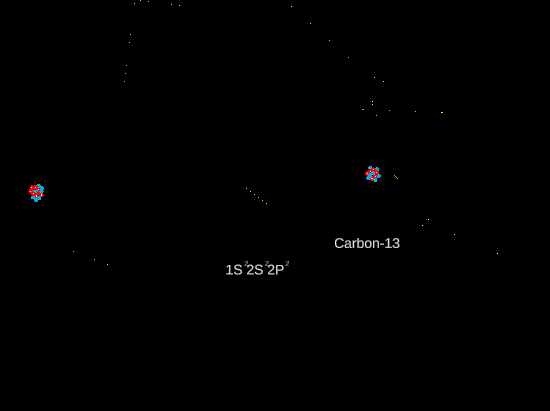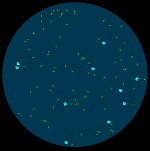Gravity Simulator is a Newtonian Gravity Simulation of the interactions between hundreds of small particles in an isolated environment. It has several simulation options to choose from, all based on the same system. At the start of the simulation, clumps of particles are spawned with random velocities, each particle is affected by Newtonian Gravity and clump together as planetesimals. You can press backspace to reset the simulation. The Camera will center towards the global center of mass at all times. The bodies can enter stable orbits, however it is far more common that the majority of mass collapses into one central body and a small amount of remaining mass escapes far away from view never to be seen again.
Category: Simulation

Atom Simulator is a simulator designed to help visualize rough atomic structure and element names along with the electron orbital notation. The simulator allows placing Protons, Neutrons, and Electrons. The Simulator is not accurate as a model of anything beyond electron orbital notation. Some major discrepancies include: Electron Orbitals, Charged Forces, Fusion, Fission and which Atomic Isotopes decay and how they undergo that decay. It is essentially just a toy to mess around with, not a realistic model of reality.
Controls:
Press the button corresponding to the particle that you wish to place. Press P and all left clicks afterwards will place a proton, Press E and all will place electrons, Press N and all will place neutrons. Press Escape to reset the simulator and have a fresh world. WASD Controls allow you to move around the camera, the closest atom to the camera center will become the follow target. If a camera is following an atom, it will respond to any changes in that atom’s velocity.
Tip: You should have roughly the same amount of neutrons as protons in your elements, if you do not do that then your atom may radioactively decay.

Evolution Simulator is a simulated petri dish in which two types of single celled life are present and competing with each other for survival. Each cell is tasked with procuring food. Prokaryotes eat the green food sources which naturally spawn over time throughout the dish. However, Eukaryotes can only eat meat food sources, dropped when another cell dies (By any means other than starvation) and so they hunt prokaryotic cells for food. When a cell meets the following conditions, it replicates into two cells (Some rules can be modified with in-game parameters):
- Reached Maturity (Elapsed Time Since Birth)
- Have Reached Their Food Requirement When a cell reproduces, its genes may be randomly mutated by small amounts. Some mutations are linked to others, IE: Cell size mutations also impact cell speed. The following cell stats are genes that can be mutated during replication:
- Size
- Speed
- Sense Range
- Health
- Attack Damage
- Food Efficiency
- Food Capacity
- Reproductive Requirement
The intended result of this simulator is to simulate Evolution over time, as the cells inside the petri dish gradually form an ecosystem with the most optimal cell builds. Internal Metrics Track Population, DNA Make-Ups, and Cell Stats over time to show the results of the simulation over time in game.
